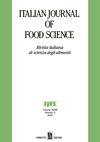不同气候条件下种植的辣木叶酚提取物对小鼠伤口愈合的促进作用
IF 3.3
4区 农林科学
Q2 FOOD SCIENCE & TECHNOLOGY
引用次数: 0
摘要
多年来,人们一直认为油辣木叶具有愈合伤口的特性。本研究旨在研究摩洛哥两个地区(姆西西和拉姆塔)种植的辣木叶的两种提取物:水提取物(AE)和乙醇提取物(EE)的抗炎和愈合功效,并以小鼠为生物模型。在卡拉胶诱导炎症后的 0 分钟、1 小时、3 小时和 5 小时,通过评估小鼠前爪的体积来监测炎症。小鼠的后爪用从 Mssisi 地区获得的油橄榄提取物处理,剂量为 50 毫克/千克。与对照组和在 Lamta 地区种植的油橄榄酚提取物相比,EE 可使水肿减轻 99.2%,AE 可使水肿减轻 91.8%。关于大鼠背侧烧伤的愈合,结果表明,与对照组相比(阴性对照组:22 天以上,阳性对照组:22 天),在伤口上涂抹为期 14 天、剂量为 50 毫克/千克的辣木软膏后,伤口完全愈合。M.Oleifera萃取物能使EE和AE的组织几乎完全修复,修复率分别为98.26%和95.34%。本文章由计算机程序翻译,如有差异,请以英文原文为准。
Wound-healing potentiation in mice treated with phenolic extracts of Moringa oleifera leaves planted at different climatic areas
For years, Moringa oleifera has been known for possessing wound-healing properties. This study aimed to investigate the effect of two extracts: aqueous extract (AE) and ethanolic extract (EE) of Moringa oleifera leaves planted at two regions (Mssisi and Lamta) in Morocco for their anti-inflammatory and healing properties, for which mice were used as a biological model. Inflammation was monitored by assessing forepaw volume of mice, measured at 0 min, 1 h, 3 h, and 5 h, after its induction by carrageenan. Hind paw of mice were treated with extracts of M. oleifera, at a dose of 50 mg/kg, obtained from Mssisi region. This resulted in reduction of edema by 99.2% with EE and by 91.8% with AE, compared to controls and the phenolic extract of M. oleifera planted at Lamta region. Regarding healing of burns induced on rat’s dorsal region; results showed that application of Moringa-based ointment for 14 days, at a dose of 50 mg/kg on wounds, resulted in total healing, compared to controls (negative control: more than 22 days, and positive control: 22 days). M. oleifera extracts resulted in nearly complete tissue repair of 98.26% and 95.34% with EE and AE, respectively.
求助全文
通过发布文献求助,成功后即可免费获取论文全文。
去求助
来源期刊

Italian Journal of Food Science
工程技术-食品科技
CiteScore
4.20
自引率
0.00%
发文量
33
审稿时长
>36 weeks
期刊介绍:
"Italian Journal of Food Science" is an international journal publishing original, basic and applied papers, reviews, short communications, surveys and opinions on food science and technology with specific reference to the Mediterranean Region. Its expanded scope includes food production, food engineering, food management, food quality, shelf-life, consumer acceptance of foodstuffs, food safety and nutrition, energy and environmental aspects of food processing on the whole life cycle.
Reviews and surveys on specific topics relevant to the advance of the Mediterranean food industry are particularly welcome.
 求助内容:
求助内容: 应助结果提醒方式:
应助结果提醒方式:


